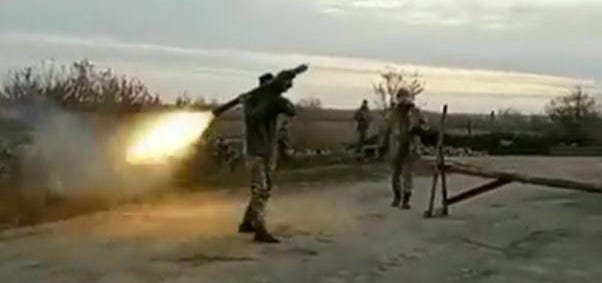The Russian air force is losing attack helicopters at a rate that should alarm Russian commanders and crews. And it’s obvious why. To use their precision-guided missiles, Russian Kamov Ka-52 gunships must climb and hover, making them visible and vulnerable to Ukrainian missileers from miles away.
“Russian attack helicopters have likely suffered particular attrition from Ukrainian man-portable air-defense systems,” the U. K. Defense Ministry explained .
The Russian air force began the wider war in Ukraine back in February with around a hundred of the twin-rotor, two-crew Ka-52s. The service has written off at least 23 of the Kamov ‘copters that outside analysts can confirm, including at least two—and potentially many more—this month. The most recent confirmed loss occurred on or around Monday.
A video that circulated online depicts a Ukrainian team firing a shoulder-fired, heat-seeking missile at a Ka-52 and reportedly destroying it. With that kill, the Kremlin’s Ka-52 inventory is down by a quarter. To be fair, the Russian air force operates hundreds of other gunships, including classic Mil Mi-24s and newer Mil Mi-28s.
But aside from a few of the latest Mi-28s, the Ka-52s are the only Russian attack helicopters that are compatible with the air force’s best anti-tank guided missile, the 90-pound Vikhr. And the Vikhr, for its part, is one of the few reliable precision weapons in the air force’s inventory. So Russian commanders have sent the Ka-52s into combat specifically to fire Vikhrs at Ukrainian tanks and fighting vehicles.
But effectively employing the missile is an unhappy experience for a Ka-52 crew. The missile is a “beam-rider. ” A gunship crew hovers a few hundred feet off the ground, shoots a laser beam at the target from as far as six miles away, then fires the missile, which follows the laser all the way to the target.
The problem is, the firing helicopter can’t move until the missile hits. And that can take tens of seconds—an eternity when Ukrainian air-defenses are nearby. The U.
K. Defense Ministry also attributed extreme Ka-52 losses to a dearth of top cover from Russian fighters, but it’s not apparent that exposing a fighter to the same air-defenses that threaten the helicopters would result in fewer shoot-downs, overall. No, it’s the technology—and the tactics it dictates—that makes Ka-52s so vulnerable.
It’s not for no reason that the U. S. Army mostly uses Hellfire anti-tank missiles, which have a “fire and forget” mode.
The crew designates a target on radar, fires the missile and immediately dives and flies and away in order to dodge return fire. By the same token, the risk gunship crews face over Ukraine explains why the Ukrainian crews in particular have adopted an extreme tactic. They fly really, really low.
As in, just 10 or 15 feet over the ground, angling up only briefly to lob unguided rockets in long, ballistic arcs toward their targets. The ballistic mode of attack isn’t very accurate, but it helps ‘copter crews to survive. Indeed, Ukraine has lost just 12 helicopters since Russia widened its war on the country back in February.
Russia has lost 52 of its own, higher-flying helicopters. “A five-meter-altitude flight makes it impossible for the enemy’s anti-aircraft defense to shoot down our ‘dragonflies,’” the Ukrainian defense ministry explained . As long as the Russian air force in Ukraine favors precision application of the Vikhr missile over the survival of the Ka-52s firing the missile, the gunship crews face extreme risk … and a shockingly short life expectancy.
.
From: forbes
URL: https://www.forbes.com/sites/davidaxe/2022/10/26/ukraine-has-shot-down-a-quarter-of-russias-best-attack-helicopters/



